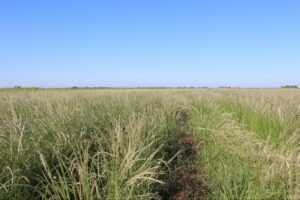Many of our customers have begun planting native grasses, and one of the most common questions we get this time of year is “How much do I need to irrigate?”. Because this question is so common and so important, we wanted to address it thoroughly.
It’s important to know how much irrigation is required when planting native grasses because it determines how long you need to manage a reclamation project before you can move on. One of the many advantages of choosing to plant native grasses is that they are drought-tolerant. This means they have higher chances of successful establishment and require less maintenance than non-native species.
The Essentials of Irrigation When Planting Native Grasses
 The question of whether to irrigate or not is a big one. For native grasses, unless there’s a solid plan to provide consistent irrigation over the crucial initial two to six months, it might be wiser to rely on natural rainfall. Irrigation can potentially encourage germination under less-than-ideal conditions, such as during extreme heat or outside the optimal planting season, leading to superficial root growth. Additionally, it’s important to note that in more humid regions (like South Texas for example), irrigating can inadvertently introduce foreign grass and weeds.
The question of whether to irrigate or not is a big one. For native grasses, unless there’s a solid plan to provide consistent irrigation over the crucial initial two to six months, it might be wiser to rely on natural rainfall. Irrigation can potentially encourage germination under less-than-ideal conditions, such as during extreme heat or outside the optimal planting season, leading to superficial root growth. Additionally, it’s important to note that in more humid regions (like South Texas for example), irrigating can inadvertently introduce foreign grass and weeds.
Because native grasses are planted so shallowly, moisture is a particular concern in semi-arid regions that often have high winds. The seeds depend on consistent soil moisture for water absorption and germination. The use of a cover crop can be an effective way to maintain moisture in the soil. The best choices are cover crops that leave behind a lasting residue or mulch.
This residue plays a critical role in shading the soil and reducing moisture loss to help native grasses develop their deep root systems. Therefore, cover crop residue that preserves surface soil moisture is indispensable for germination and developing a robust root system in native grasses.
Maximizing Drought Tolerance with Native Grasses
Because native grasses have such deep root systems, it’s important to maximize wet seasons when possible – ideally, you want the seeds to germinate in a way that most closely resembles Mother Nature’s perfect rhythms. If rainfall does not occur (or you are planting outside the typical season), we recommend light frequent watering to maintain adequate moisture for up to three weeks. You want the soil to be moist, but not saturated. If you’re able to time your planting close to rainfall, you probably won’t need additional irrigation.
Once established, native grasses are highly drought tolerant. They’re also incredibly low-maintenance, requiring little to no watering. The thing natives need most is time. It’s best to allow land at least one year before grazing. In that time, the plants can develop their substantial root systems that will hold water, assist in recharging the aquifer, and help prevent erosion. But good things will come to those willing to wait: because native species are perfectly adapted to their environment, you see visible benefits and results: an increase in local wildlife, higher numbers of pollinators, and greater soil stability.
Choosing Native Grasses for More Sustainable Projects
Incorporating native seeds into your projects requires thoughtful planning and execution. Before you even need to think about irrigating, you need to be sure you’re puting the right blend of seeds into the ground. Not all soils are created equal, and each native grass has traits that work best in different soil types.
To identify the right native seed for your project, you have options. Our team can help you create a custom seed blend that fits the the characteristics of your soil. Or, you can use a tool like Seed-Spec to to quickly and effectively identify a custom seed blend that matches the site-specific needs of your project.
Seed-Spec: Finding the Right Fit for Your Land
Selecting the right native species for your project is crucial, but it doesn’t have to be daunting. Seed-Spec, our proprietary web application, simplifies this process. By generating custom blends adapted to your specific soil and climate, Seed-Spec ensures your project benefits from native species’ drought tolerance and ecological compatibility. It’s as simple as drawing the points of your project, viewing your custom report, choosing your desired percentages, and purchasing your custom seed blend.
In embracing native seeds, you’re not just picking a landscaping or conservation solution; you’re investing in a future where land management works in harmony with nature’s rhythms. Whether you’re combating drought, reclaiming a construction site, or grazing livestock, native seeds offer a path to achieving your goals and creating a biodiverse landscape.
Prep and Plant Like the Pros
Looking for more guidance from our Reclamation Specialists? Here are some resources to read through on planting and establishment:
- A Guide to Seeding and Establishing Native Species
- Native Seed Planting Recommendations
- Re-establishing Native Vegetation
Interested in exploring the right native seed blend for your project? Reach out to us at Bamert Seed Company, and let’s grow something great together.



